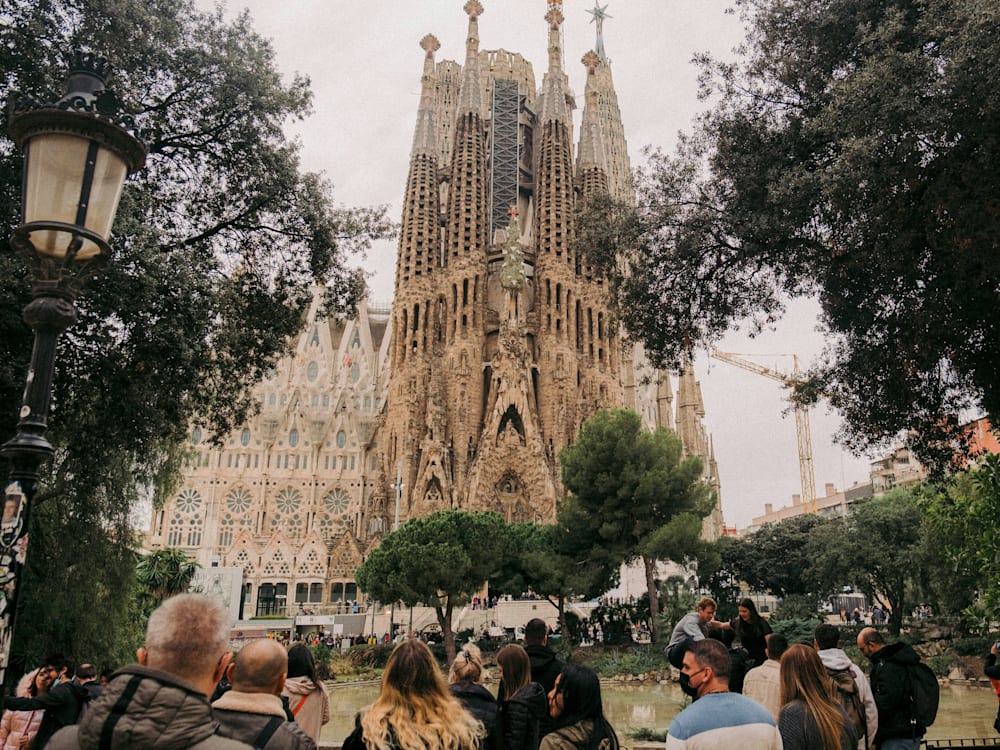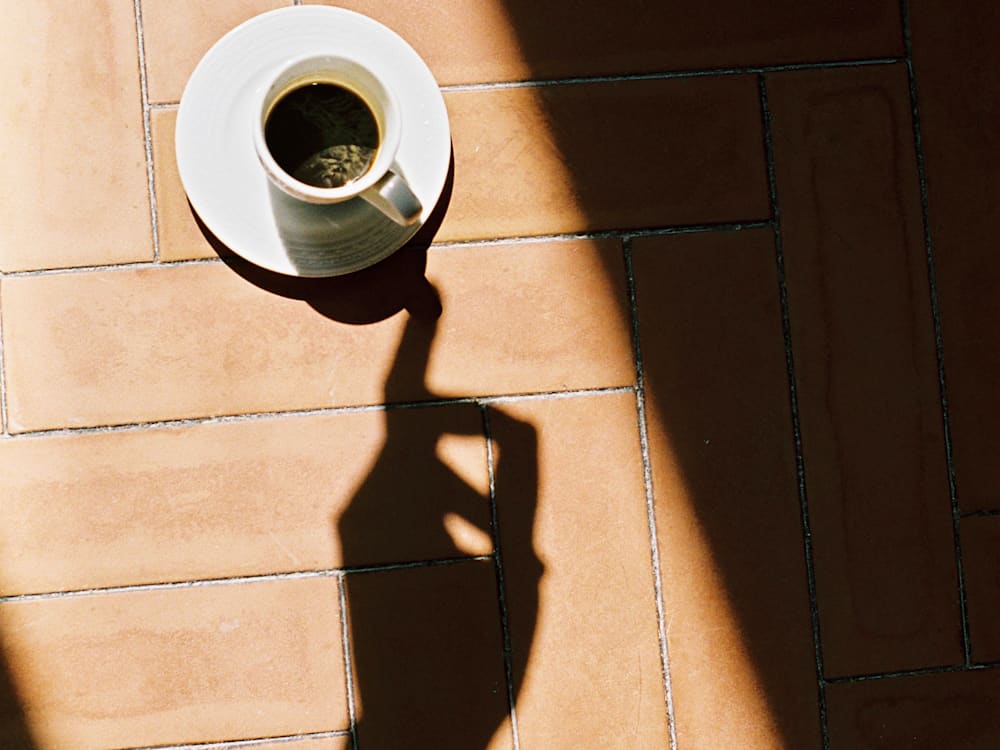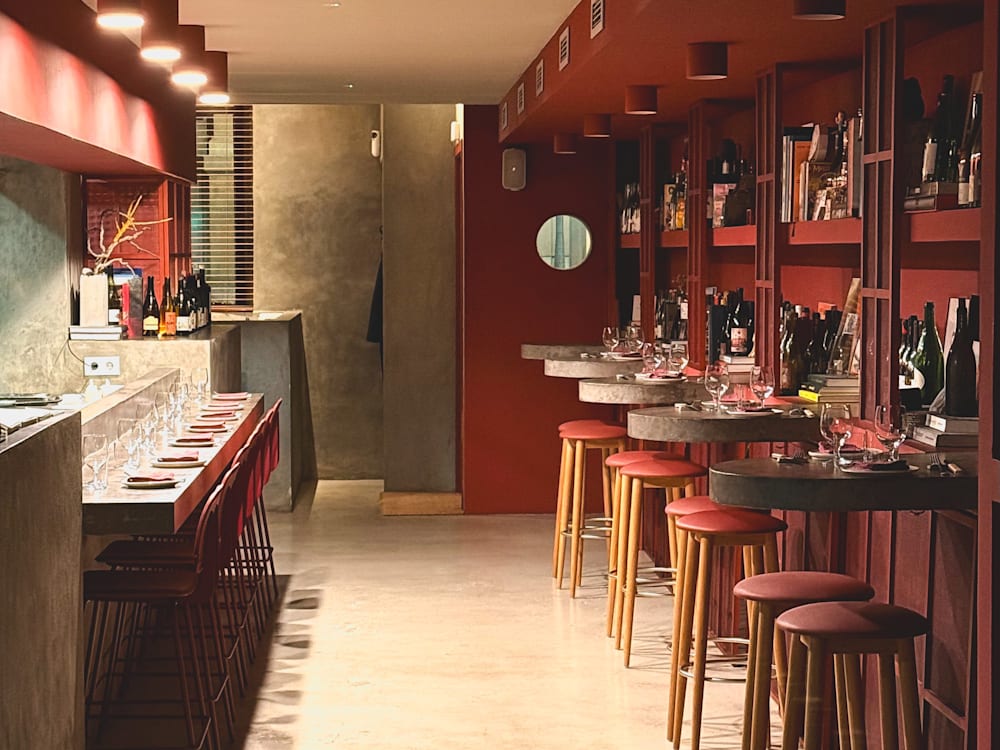Barcelona, some time in the late 19th century: Catalan architect Antoni Gaudí is dreaming up a church so fantastical it will take over a century of construction to… remain unfinished. Soon, wealthy tycoons — your early 1900s’ Musks and Bezoses — are commissioning the name-droppiest architects to outdo the neighbours. It’s peak Modernisme, Catalonia’s maximalist take on Art Nouveau, where floral motifs, fantastical façades and patterned tiles will turn the new housing project of Eixample (pronounced Ee-sham-pla, meaning ‘expansion’) into a structural wonderland.
Today, Eixample’s airy, grid-structured streets offer a meditative breather after navigating the tangle of the Gothic Quarter. The neighbourhood is a tale of two halves: the right side (Dreta de l’Eixample) — east of Carrer de Balmes and home to wonder-constructions like Casa Batlló, another Gaudí — is smarter and more sedate.
Go left to L’Esquerra, and things feel freer. Rainbow flags mark ‘Gaixample’; an LGBTQ+ hub where it’s perfectly normal to see grandmas wheeling their trolley bags past window displays of latex jockstraps. The left’s restaurant scene exploded post-pandemic, while newly pedestrianised street Consell de Cent cuts across Eixample’s entirety — providing a far less touristy La Rambla 2.0 that’s speckled with boutiques and terraces of vermouth-dispensing bars.
Want to know the best nooks? This resident welcomes you into their address book to help you craft the perfect weekend break in Barcelona…
What to do

It’s hard to verbalise the magic you feel inside the Sagrada Família, other than to simply say: see it. While the exterior is mad and exuberant, the interior’s sunflower-hued light — kaleidoscopic, almost, as it passes through stained glass — is otherworldly. In summer, book tickets at least three weeks in advance.
To see Gaudí’s other Eixample gems at their best, visit at quieter times. From March to November, Casa Batlló’s Magical Nights combine an hour-long visit with a rooftop concert (from rock classics to rumba) with a glass of cava thrown in. The high point of La Pedrera’s guided Night Experience is a rooftop projection show; and Friday nights in June and July host the Talents Jazz Festival, where the city’s brightest emerging musicians perform on a sunset-lit rooftop stage.
The best breakfasts in Eixample
Barcelona breakfasts rarely start before 9.30am — blame those 10pm dinners. When they do, Funky Eatery’s ‘Barcelona Breakfast’ features pan con tomate (warm bread slathered in olive oil and tomato), manchego cheese and jamón ibérico, as well as Continental twists like babka French toast or Turkish mezze. Perch on the terrace or inside among exposed brick walls and fresh flowers; if you’re still in siesta mode, the coffee smoothie (double espresso, banana, dates and milk) is rocket fuel.
Eat My Trip’s colour-explosion plates are created with one eye on social coverage (the pancakes are indeed topped with candy floss), but the queue doesn’t lie — its atypical dishes, such as the Alps Brunch skillet of truffled roast potatoes, poached eggs, melted cheese and mushrooms, are flavour-packed. Nearby, sustainability-focused Faire, which plants a tree for each bill handed out, whips up chia puddings, açaí bowls, avo toasts and all manner of eggs, alongside an alt-latte line-up spanning mushroom coffee, matcha and homemade chai.
Salut Bistro, which transforms into a breezy early-doors restaurant after 7.30pm, opens with croque madames, shakshuka and croissants. If the alfresco spots are full, the interior’s marble tables and green-leather benches befit the most important meal of the day. For something on the go, bougie bakery Origo’s sourdough loaves and cinnamon twists are widely considered the city’s best baked goods (worth noting: wine is sold here, too).
The best coffee in Eixample

You smell LOT Roasters before you see it — recently ground beans mixing with hot spiced cardamom and baked goods so fresh it’s like the oven door has just opened. Then you walk inside and it looks as beautiful as it smells. Original patterned floor tiles house sacks-of-coffee beans-turned-seats, all graced by the bottoms of Barcelona’s coolest dressers and their dogs. No one’s in a rush, but that’s kind of the point — sit back, sip, style-watch and savour.
Onis Coffee is teeny but scene-y. Styling is intentionally minimal apart from a curated edit of original artworks in gilded frames, a crystal chandelier and one window seat inside and out (AKA: the spot). Excellent brews come from Barcelona-based Three Marks Coffee and guest roasters from across Europe, and there’s a small-but-willpower-straining collection of buns and pastries.
Where to shop
Passeig de Gràcia is one of those still-magnificent European high streets without a vaping shop in sight. The flagships of locals Loewe and Massimo Dutti impress for the buildings alone: Casa Loewe’s pink pillars are by Modernista master Lluís Domènech i Montaner (inside, the art collection includes ceramics by some bloke called Picasso). Meanwhile, Massimo Dutti occupies the former house-studio of painter Ramon Casas — the first floor is a jawdropper, with its flower-carved pillars, mosaic floors and secret terrace overlooking Gaudí’s La Pedrera.
Creative kudos goes to Thinking Mu, which displays its sustainable casualwear (made from hemp, organic cotton and biofibres) atop micro-cement tables in a limewashed store that hosts coffee residencies by local roasters. For kids, Bobo Choses’s colour-pop outfits — all Vichy checks and cool graphic tees — sit inside an equally vivid store: you enter via theatre curtains, and kids will likely beeline to the tent to get den-building.
Carrer d’Enric Granados is a one-street wonder for independent brands: peruse The Avant’s slow-made womenswear, Curated By’s lifestyle store and La Manso’s stackable costume rings.
Over on the Dreta side, don’t miss stylist Alissa Ashcraft’s flawless edit of pre-loved premium labels (including Philo-era Céline) at The Favorite Vintage. And Altell 112 is the coolest address in town for unisex, indie-label streetwear, such as Aries and ROA.
Where to eat dinner

Behind an intentionally unmarked door, speakeasy-slash-restaurant Suru Bar is one of left-side Eixample’s most memorable examples of young-authored Catalan cuisine (open mid-week only). Britpop blares, and concrete, steel and dark-red decor sets the stage for low-intervention wines and flavour-upending dishes, such as sweet-and-sticky skewers. To dial dishes back to the classics, buzzy Malparit serves perfectly baked market fish (plus excellent chips) on squishy banquette seating that feels like Soho House meets a summer house.
The best of the under-€100 tasting menus are found at Âme and Besta. Âme melds French cooking into a kaiseki concept (cohesively sequenced Japanese small plates); everything is delicate and cooked to absolute perfection, from the plump scallops to the divine duck. Besta is Catalan-Galician, meaning seafood from both the Med and the Atlantic, and that’s as much detail as the menu gives you. Dishes are explained as they appear — the constant being superb freshness.
And for more step-count fuel after dinner, DelaCrem’s ice-cream flavours change monthly to reflect what’s harvested locally and seasonally.
Where to drink
While the pet-nat crowd quaffs in Poblenou, Eixample sticks to classics like vermouth. Hole-in-the-wall vermutería Morro Fi was launched by local vermouth bloggers to serve their own blends of the botanical, fortified wine. Inside, there’s enough wiggle-room for 12, or enjoy the Catalan pre-meal ritual of la hora de la vermut on the street, where vermouth is poured over a hunk of ice and an orange slice, and accompanied by salty skewers of olives, anchovies and piparras (Basque chilli peppers).
An atmospheric outdoor drinking spot has appeared where Carrer del Consell de Cent crosses Carrer de Girona. This spot was once lanes of traffic; today, its benches and flowerbeds are a triumph of urban regeneration. People-watch from the terrace at Betlem, a family-run bar since 1892, that rolls out croquetas, cheese plates and well-priced wines by the glass. Around the corner on Carrer de Girona, you’ll spot the green doors and bygone-era awning of Café del Centre — this Parisian-esque former casino, established in 1873, is a great bet for evening chatter and drink-clinking surrounded by charming original decor.
For going out-out, there’s Sips, which was crowned the world’s best bar in 2023. Problem is, there’s also the queue for Sips. Dodge the hour-long wait at The Alchemix, where inventive cocktails meet mouth-tingling South-East Asian bites, courtesy of owner Ignacio’s stint at Bangkok’s Michelin-starred Gaggan.
Where to stay

If you like your decor more modern than Modernista, Ohla Eixample Hotel cuts the chintz for a lesson in sleek, steel-pillared minimalism. Nowhere more so than on the roof, where a domino-shaped pool lets you hug the building’s edge… should you dare. One less fright: it’s heated all year round. Downstairs, Xerta restaurant specialises in seafood from the rice fields of the Ebro Delta near Tarragona — the set-price, mid-week lunch menu is a particular steal, throwing in two glasses of wine.
If Ohla’s all about the pool, Alma Barcelona is all about the garden. You’d never know it from the townhouse façade, but the back conceals a large, established green space with tree-shaded sofas made for sipping mezcal-infused house cocktails. Alma is like the glamorous aunt of the city’s hotel scene: all herringbone wooden floors, Aesop-lined bath tubs and limewashed neutrals. A spa with an indoor pool, Pilates classes and a private sun terrace seal the (very smart) deal.
For stealth-wealth decor (like Santa & Cole lamps) and the feel of an ‘in’ spot, Casa Sagnier draws well-heeled locals and visitors. For one thing, there’s its pedigree: it’s the former home and studio of Enric Sagnier, Barcelona’s most prolific Modernista architect (who designed 380 buildings, if you fancy a counting challenge). Secondly, there’s its library-turned-eatery, Cafè de l’Arquitecte, where cortado-fuelled catch-ups unfold on the window seats and business lunches natter inside. Located on the corner of plant-filled Passatge de la Concepció, with great evening haunts like Pur (for dinner) and Boca Grande (for a nightcap), Casa Sagnier offers lively surrounds, counterbalanced with some blissfully private off-bedroom terraces.
Explore the rest of Barcelona in a weekend or see the city’s best boutique hotels
Freelance journalist Gemma Askham started her career as a motoring writer where, a week into the job, she was sent first class to Thailand to take a pick-up truck off-road. Since then, her career path has been smoother, but certainly not more sedentary: she’s lived in London, Sydney, Paris and moved to Barcelona in 2017 with her half-Swedish, half-Spanish husband. Gemma’s writing has appeared in leading British and international titles, including Condé Nast Traveler, The Times, Glamour, Grazia and Elle.



